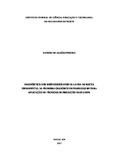Diagnóstico dos resíduos sólidos da lavra de rocha ornamental da pedreira Granorte em Parelhas-RN para aplicação de técnicas de produção mais limpa

Visualizar/
Data
2017-07-19Autor
Pereira, Ranieri de Araújo
http://lattes.cnpq.br/9400029863166967
Metadado
Mostrar registro completoResumo
The mining of ornamental rocks is an important economic activity for the State of Rio Grande do Norte. However, it is worth mentioning that ornamental rock mining produces large volumes of solid waste in the mining operation. This paper deals with the environmental and process diagnosis with a view to implementing the Cleaner Production environmental management tool. The case study was carried out between 2016 and 2017, in the quarry of the company Granorte - Mineração de Mármores e Granitos do Rio Grande do Norte, located in the Boa Vista dos Negros site in Parelhas-RN. The objective of this work was to diagnose the solid waste generation situation in the mining fronts. The diagnosis for the implementation of Cleaner Production techniques for ornamental rock mining followed the methodology of SENAI's National Center for Clean Technologies. It has had as stages, the managerial commitment through sensitization, identification of barriers and solutions, elaboration of the flow chart of the mining activity and environmental and process diagnosis. The programmed activities were developed and organized involving bibliographical research and data collection of the mining process, field visit and lab work. The bibliographic research was done through consultation in databases, magazines, periodicals and books. For the case study visits were made to the quarry area to obtain information and observations of the production process. Two residue samples were collected for X-Ray Fluorescence type chemical analysis. These analyzes identified small trace elements of rare earth elements, as well as the presence of silicon oxide in percentages that can be used. The amount of rock and soil moved during the study period was 17,487.00 tons, of which 11,768.75 were discarded for the waste pile, and 5,718.25 tons as a block product. The study identified that 99.97% by mass of the solid residues generated in the mining fronts are fragments of rocks. However, the results have also shown that Cleaner Production techniques such as process modifications and the application of good operating practices based on mine planning and the definition of mining advances through structural geology analyzes can significantly reduce losses and Consequently the generation of waste. And that internal and external recycling through mineral processing for waste use in construction and other industries are alternatives to the residue that is stored in the form of sterile piles.



